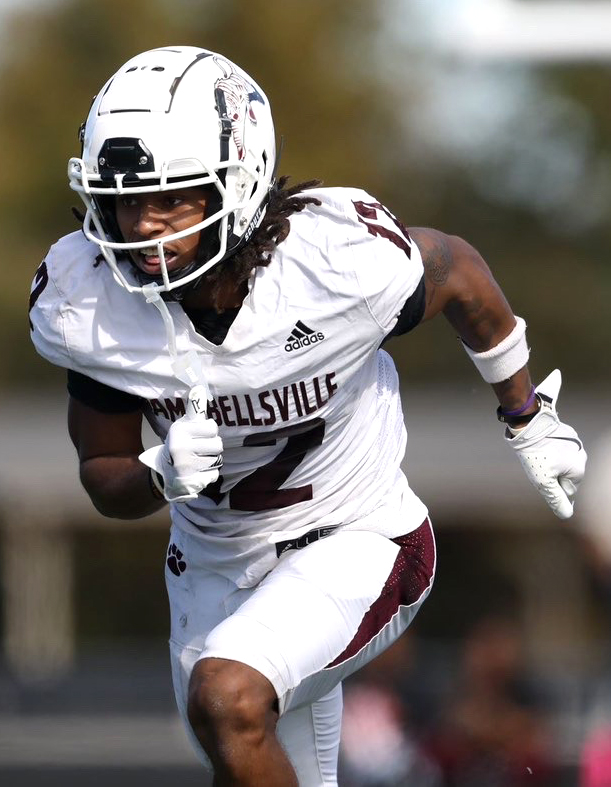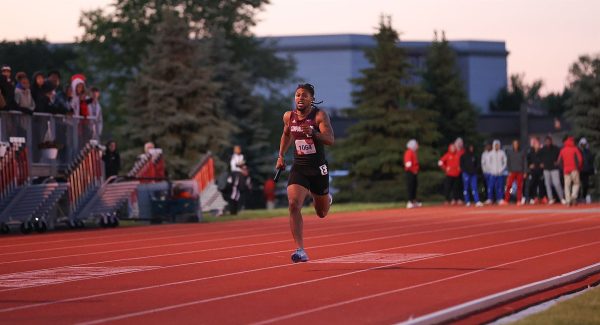
Campbellsville University senior Chris Thomas is a dual sports athlete. He plays football and runs track for CU. (Photo courtesy of CU Sports Information)
Most athletes in college play one sport and must manage their schoolwork and practices. Adding another sport can be a very demanding responsibility, both mentally and physically. Campbellsville University senior Chris Thomas knows exactly how that feels and, according to him, it’s not easy.
Thomas began playing football at four years old and started running track his junior year of high school. For many athletes, this may have been a common theme in high school, but the transition to college usually marks the end of one if not all sports they’ve played. But, not for Thomas, which has brought him some advantages and disadvantages throughout his career.
“With doing football and track, it has allowed me to maximize my athleticism,” Thomas said. “I’ve gotten a lot faster, a lot stronger and quicker than most people have. I’m able to fully take advantage of my full athletic ability doing both.”

But, with advantages comes some disadvantages. Thomas is fighting the battle of competing on two collegiate sports teams.
“Time management, my body, recovery, you know it’s a lot on the body going from one sport to the next. It’s very taxing because there is really no break in between,” Thomas said. “I probably get maybe two, three weeks in between each one, and then I have to transition from one sport to another. So that’s probably the biggest disadvantage, recovery time and time management.”
Time management being an issue can cause problems for anyone, but especially a dual-sport athlete. Thomas has found ways to combat this and makes sure he’s staying on top of his loaded schedule.
“I will focus on one sport and then continue to do my schoolwork like any other normal student,” Thomas said. “And then after that, I will transition and focus on track and whatever we have to do for that, while still staying on top of my schoolwork.”
College athletics are very time-consuming. If you play a sport in college most of the time you are doing stuff for that sport year-round. And some coaches expect you to be committed to that sport for the whole year because of what it takes to be the best. Fortunately for Thomas, this has not been a problem for him. In fact, it has been the opposite.
“Majority of the coaches I’ve talked to have been supportive of it, even in college,” Thomas said. “The coaches preferred when I was getting recruited for me to do both. They expressed that they liked multisport athletes, and it shows versatility, being able to do both. So, I think it was pretty good overall support.”
Thomas has built a routine to help him maximize his time and take care of his body in the best way possible.
“I just plan around the schedule. For football, obviously we got camp. You got to wake up early,” Thomas said. “Get your body ready right, get your mind right, go through the camp process and then start the season.”
It also puts a huge toll on his body playing both sports. Football is a physically taxing sport in its nature. The physicality and tackling aspect of football is rough. So, add that on top of running constantly for track, it can be a difficult process.
“I would say it has put a big toll on my body,” Thomas said. “It’s very physically taxing… I’ve had to focus a lot more on getting my rest and getting recovery when I can, so I can perform at my best when the time comes.”
Although it’s very taxing on his body and he spends a lot of time recovering and getting sleep, playing both sports has benefited his ability to perform for each.
“Track has definitely helped my football performance,” Thomas said. “I’m able to be more athletic on the field and faster. I can play a lot longer than most because of my lung capacity. I’m more explosive and stronger than most football players in general.”
Thomas knows all too well what it takes to be a collegiate dual-sport athlete and the amount of time and effort it takes to maintain it. CU Head Football Coach Jacob Russell is also familiar with what it takes. Russell was a dual-sport athlete in college, playing baseball and football at the University of Kentucky, Eastern Kentucky University and Campbellsville University.
“I played four sports in high school- football, baseball, basketball and golf,” Russell said. “So, it was just kind of natural for me to be playing multiple sports.”
Russell, like Thomas, found some pros and cons with playing two sports. But it gave him a lot of advantages that he’s grateful for.
“In college your sport is year-round, whether it’s football, baseball or anything else. But I do think one thing it gave me was balance,” Russell said. “Baseball and football are probably two of the most opposite sports you can get. Football’s a very intense, very high speed and physical sport. Where baseball is more of a patient game, a slower pace. There was a lot of things I practiced and learned in baseball that helped me in football and definitely vice versa. Things that I was practicing, whether it’s just skills or mental things, emotional things that you learn in football, that you’re taking to baseball.”
Time management was also something Russell faced in his time doing both sports.
“I would go and do quarterback workouts with my coach in the indoor facility in January and February at 5:30 a.m. and then go get on a bus at 9 a.m. and go and play two baseball games that day,” Russell said. “Would I have played better in those games if I wasn’t doing quarterback workouts at 5:30? In theory, yes, but I still believe that it gave me an advantage, because again whether I realized it or not, I was practicing and learning things that helped me become a better baseball player through those workouts and vice versa. So, time management was very tough.”
Unlike Thomas, Russell did have some criticism from coaches in his recruiting process when he let them know he wanted to play both football and baseball.
“There were coaches that didn’t like it in the recruiting process,” Russell said. “Some of the bigger schools that were recruiting me for football, they said baseball was not an option. There were some that I think were kind of a little hesitant, but said, maybe it’s an option. One of the big reasons I chose Eastern Kentucky University was that they were totally on board.”
Russell takes steps even to this day to make sure he is in good shape because of the toll it put on his body in his college years. This just shows how much of a taxing process it can be, and the amount of effort involved.
“I really try to stay in shape with my diet and exercise now because of the toll I put on my body when I was in my 20’s,” Russell said. “I really think I was extremely lucky. I worked really hard to keep myself in shape, but I never had a serious injury. But, no doubt, I would take a little bit of soreness and the occasional ache for what I got out of playing those sports, for sure.”
The benefits of being a dual-sport athlete help with the physical side of things. But also, the mental side, according to Jeff Blank, author of “Can a college student participate in two sports” on Sportslawblogger.com.
“Playing multiple sports can improve mental health by reducing burnout caused by grueling practice for the same sport,” Blank said. “By adding variety, athletes can look forward to playing a new sport, interact with other team members, challenge different brains and body parts, and feel renewed excitement for physical activity.”
Being a dual-sport athlete is very demanding for Thomas. With classes, practices, games and meets he has a lot on his plate. Despite this, Thomas has been able to manage all of that while still loving what he does.
“I would say football is my first love,” he said. “But I’ve really grown to enjoy track and really love it.”